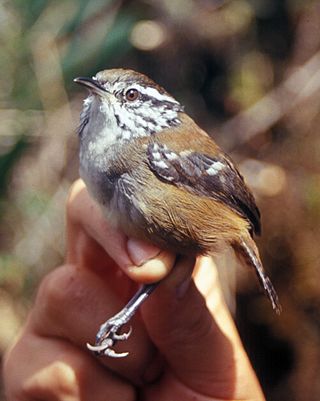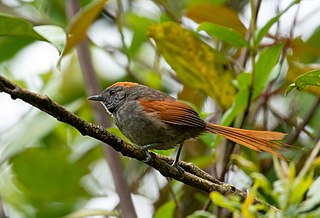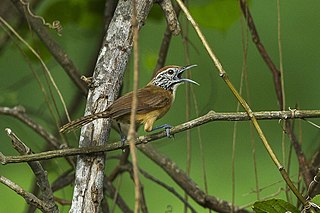
The rufous-breasted wren is a small songbird of the family Troglodytidae. It is found in Colombia, Costa Rica, Panama, Trinidad and Tobago, and Venezuela.

The plain xenops is a passerine bird in the Furnariinae subfamily of the ovenbird family Furnariidae. It is found in the tropical New World from southern Mexico south as far as northern Bolivia and east across Brazil.

The speckled chachalaca is a species of bird in the family Cracidae, the chachalacas, guans, and curassows. It is found in Bolivia, Brazil, Colombia, Ecuador, and Peru.

The many-striped canastero is a species of passerine bird in the Furnariinae subfamily of the ovenbird family Furnariidae. It is found in Colombia, Ecuador, and Peru.

The stout-billed cinclodes is a species of bird in the Furnariinae subfamily of the ovenbird family Furnariidae. It is found in Colombia and Ecuador.

The grey-breasted wood wren is a species of bird in the family Troglodytidae. It is found from Mexico to Bolivia.

The bar-winged wood wren is a species of bird in the family Troglodytidae. It is found in southern Ecuador and northern Peru.

The southern nightingale-wren, also known as the scaly-breasted wren, is a species of bird in the family Troglodytidae. It is found in Bolivia, Brazil, Colombia, Costa Rica, Ecuador, Panama, Peru, and Venezuela.

Azara's spinetail is a species of bird in the Furnariinae subfamily of the ovenbird family Furnariidae. It is found in Argentina, Bolivia, Colombia, Ecuador, Peru, and Venezuela.

The lineated foliage-gleaner is a species of bird in the Furnariinae subfamily of the ovenbird family Furnariidae. It is found in Colombia, Costa Rica, Ecuador, Panama, Peru, and Venezuela.

The Inca wren is a species of bird in the family Troglodytidae. It is endemic to Peru.

The black-bellied wren is a species of bird in the family Troglodytidae. It is found in Colombia, Costa Rica, and Panama.

The happy wren is a species of bird in the family Troglodytidae. It is endemic to the Pacific slope of western Mexico, from the state of Sonora to the state of Oaxaca, and also on islands west of the Mexican coast. As with other species of Pheugopedius, older sources classify it within genus Thryothorus. Some authorities have treated it as a subspecies of P. rutilus or P. sclateri. There is significant geographical variation, and six subspecies are recognized: P. f. sonorae is found in southern Sonora and northern Sinaloa; P. f. pallidus is found in central Sinaloa, western Durango and southwards to Jalisco and Michoacán; P. f. lawrencii and P. f. magdalenae are found on different islands of the Islas Marías; P. f. grandis is found in the Balsas River basin, and the nominate subspecies, P. f. felix in southwestern Mexico from Jalisco to Oaxaca.

The moustached wren is a species of bird in the family Troglodytidae. It is found in Bolivia, Brazil, and Peru.

The spot-breasted wren is a species of bird in the family Troglodytidae. It is found in Belize, Costa Rica, El Salvador, Guatemala, Honduras, Mexico, and Nicaragua.

The whiskered wren is a species of bird in the family Troglodytidae. It is found in Colombia, Ecuador, and Venezuela.

The bay wren is a species of bird in the family Troglodytidae. It is native to southern Central America and northwestern South America.

The sooty-headed wren is a species of bird in the family Troglodytidae. It is found in Colombia and Panama.

The mountain wren is a species of bird in the family Troglodytidae. It is found in the Andes of northwestern Argentina, Bolivia, Colombia, Ecuador, Peru, and western Venezuela.

The Ecuadorian piculet is a species of bird in subfamily Picumninae of the woodpecker family Picidae. It is found in Ecuador and Peru.






















